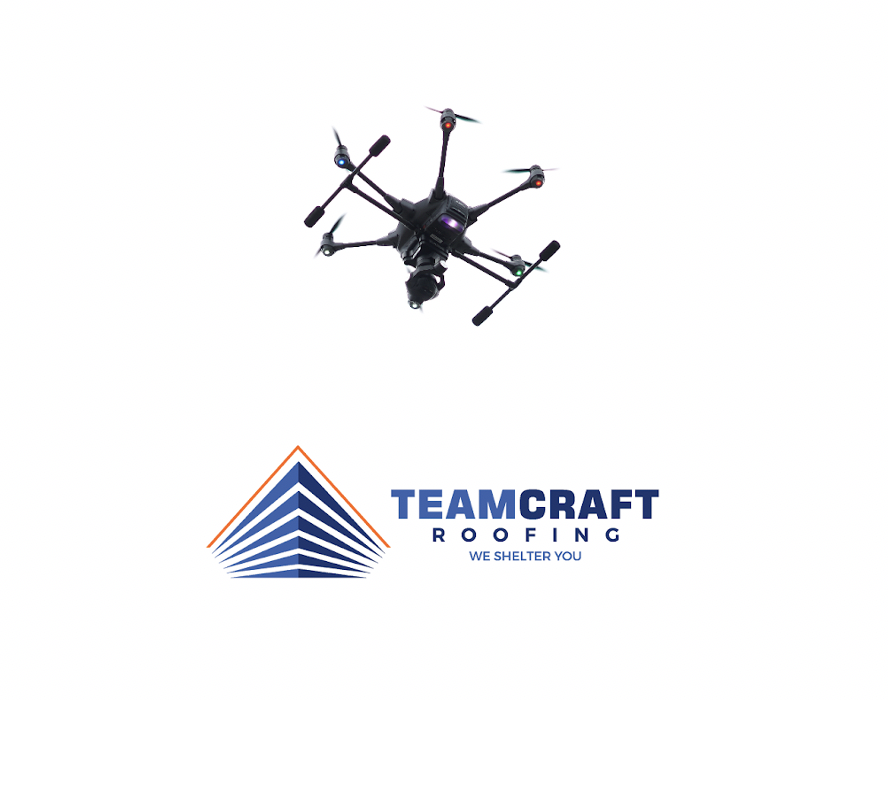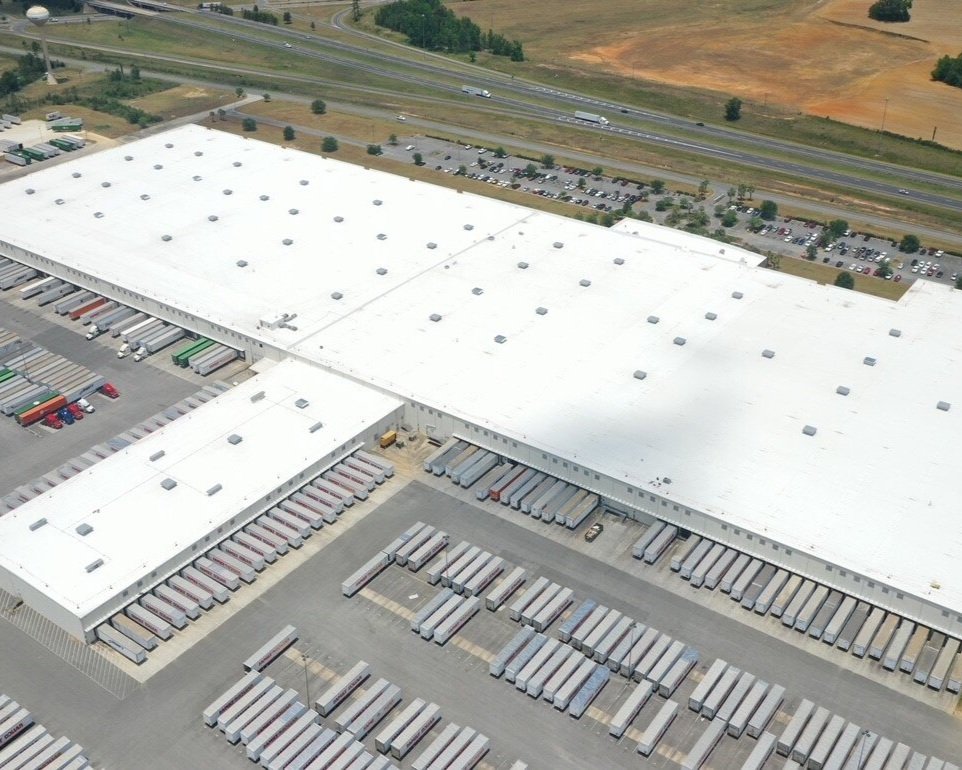How Commercial Roofing Experts Use Drone Technology to Assess Roofs
TeamCraft understands the value of modern technology in the efficient management of roofing systems. We integrate technology into many aspects of the roofing process, but one of the most routine utilizations is our use of Unmanned Aerial Vehicles (more commonly known as drone) technology. Drones offer valuable information that is not readily attainable on roof walks. For example, our drones are able to capture infrared temperature readings on the roofing system.
The roofing industry continues to incorporate increasingly sophisticated technologies into its operations. Technology improves employee safety in hazardous environments when it is utilized appropriately.
Drones are a good example of technology that offers safety benefits to commercial roofers. Most notably that drones allow for a roof to be inspected from the ground for severe fall hazards. In the past roof inspections necessitated stepping on potentially unsafe decking to survey what work needed to be performed. Today our roofing experts can visually inspect the roof via drone before walking on a potentially unsafe surface.
Drone Technology in Roofing
The first step for most commercial roofing projects is to plan your roof inspection. The roof inspection will identify the roofing system’s age, building material, areas of concern, and any unusual building features that could affect the project. Re-roofing projects will specifically be evaluated for construction defect. If areas of the roof are defective, the roofing inspector will take additional detailed surveys and revert back to the client with a strategy for the necessary remediation. Some examples of roofing defects include standing water on a roof, losing excessive heat from the building via the roof, ongoing water intrusion, etc. Many property inspectors will not lay eyes on the roof when performing building inspections; as such, it is imperative to hire a roofing professional to perform your roof inspection.
Traditional inspections begin with a visual walking inspection, after which core samples are taken. TeamCraft takes a unique approach as a technological leader in the roofing industry. The first step in virtually every roofing inspection we perform is to take drone footage of the potential construction site. Our roofing consultants are licensed drone pilots and they are trained to safely survey any potential construction site. By taking drone footage, the consultant ensures that they are not going to unknowingly walk onto an unsafe structure. When possibly significant hazards are identified on a roof our consultants create a plan to safely perform the physical roof walk. This might involve tying off to a fall protection system, or accessing the roof from an unusual access point. Roofing inspections are made safer by utilizing technology.
Another benefit of drones is that we are able to minimize disturbances to our clients on roof inspections. At our customers request, we can even perform a roof inspection flyover without a customer representative present. After each inspection we send a detailed report to the customer explaining our findings and recommendations. Additionally, drones make roof inspections faster, and consequently more cost effective, since the consultant is generally able to pinpoint the problem areas on the roof prior to the physical inspection.
TeamCraft Roofing’s drone pilots are certified by the FAA. We can provide verification of our remote pilot certificates of completion, and stay on top of the regulations surrounding drone piloting. Our pilots take a minimum of one continuing education drone course every two years, and are always thinking about the best and safest way to utilize this emerging technology.
Teamcraft’s skill goes beyond basic drone operations. We also have specific thermal imaging software on our drones that allows our expert consultants to view thermal scans during their flyovers. Our Registered Roof Consultants understand how to interpret and analyze these thermal images to best address potential roof problems.
Aerial Imaging from Drones
Arguably, the most valuable capability of a drone is its ability to do wide-scale unmanned surveillance. A drone can:
Survey an entire building.
Get close-up shots of roof surfaces, chimneys, and vents that are otherwise unreachable.
Take thermal scans of roof surfaces.
Transfer measurements and estimates of property damage in a time efficient manner.
Thus, drones serve two functions for roofing inspections; they allow for a visual review of the roof surface and capture infrared scans that can identify potential defect in the roofing material.
Infrared Thermography
Our military-grade infrared technology is comparable to an MRI of the roof. To better understand the process of infrared readings we will explain the basic science behind the technology. The fundamental building block of thermal imaging development is that all objects above absolute zero vibrate. These vibrations emit infrared energy which varies in intensity depending upon the speed of vibration. As a surface becomes warmer its molecules vibrate faster, which ultimately gives off stronger (and thus warmer) infrared heat readings. Our drones contain special sensors that illuminate the spectrum of infrared readings that are not visible to the unaided eye.
It is important to understand that thermal energy (the generator of infrared heat) is either emitted, absorbed or reflected from any given surface. The sensors cannot see through the building, but give insight as to what thermal energy activity is taking place on the roof system.
When moisture gets into roofing materials it adds thermal mass which causes the compromised roof material to hold onto heat much longer than the dry material nearby. Under the right drone calibration, the thermal camera can capture heat on the roof the way standard cameras capture visible light. When this is performed correctly the footage will show the extent of moisture problems within a roofing system. Thermographic imaging offers the building owner more information about where moisture is hidden than a traditional roof walk; However, not all thermal anomalies require repair. Certain roofing materials and wear patterns produce unusual thermal signatures that may look like water underneath the roofing membrane, but are not.
The image to the left presents an example of thermal imaging at work. The temperature scale is the vertical bar on the right, and the moisture located on the roof is highlighted by an arrow.
When a consultant is searching for moisture on a roof they will likely perform their fly over in the evening. This allows for the roof to have been heated throughout the day, and will better show temperature differences between the dry and moist areas of the building surface. Areas of the roof with water intrusion or pooling will cool down significantly faster than the dry portions of the roof. As such, the consultants can identify where the unusually cool portions on the roof are and focus on those areas when they walk the roof.
Infrared scanning is a great tool, but not a complete solution for roof inspections. Below we identify a few conditions that can create inaccuracies in infrared drone readings:
There is the potential for facilities with lots of heavy machinery to vent hot fumes via their exhaust systems through or near the roof. The exhaust systems could be working perfectly, yet show unusual infrared readings. If there are unusual ‘hot trails’ on an infrared image the roof consultant performing the inspection will ask the customer about the internal machinery vents.
Daytime shading may cause irregular heat conduction on the roof leading to unusual readings.
Chunks of gravel on the roof surface could hide underlying moisture from being picked up by the infrared scan.
If there is high humidity the imaging can be inconclusive (generally above 50% humidity can cause problems).
Any form of precipitation can cause inconsistency with thermal images.
The readings will be inaccurate if the drone is flown during the day and sunlight reflects off the roof directly at the thermal lens .
The Best of Both Worlds:
Aerial Drone With Built-In Thermal Imaging
The thermal imaging cameras mounted on aerial drones are useful mapping tools. The drones highlight temperature differences that can indicate the origin of a leak or where there is moist or otherwise compromised insulation. The footage allows the roof consultant operating the drone to assess damage without having to peel back layers of the roof. The drone flyover can cut back the number of core samples needed from a roof inspection.
The information provided by thermographic imaging is useful to property managers as well as contractors. A few of its primary uses are outlined below:
With the interpretation from a certified infrared professional, these maps can be used as a reference to understand and start action outlines.
Thermographic imaging can aid in the process of budgeting and assessing roofing needs.
Previously, the initial method for detecting water damage was an expensive and inefficient “guess and check” plan, which sometimes required the removal of the building’s exterior to get an accurate assessment. Contractors can discover otherwise unobservable water damage or moisture by utilizing drone’s thermographic imaging.
Some insurance companies have used thermal maps to help asses the condition of a roof, and consequently its property insurance rate.
What Are the Advantages of Drone Technology?
Safety
Drones allow roofing companies to perform preliminary roof inspections without risking their personal safety on a possibly dangerous building structure. This dramatically decreases the hazards associated with roof inspection. According to OSHA, falls are the leading cause of death in the construction industry, accounting for over 3,500 fatalities between 2003 and 2013. Falls from roofs accounted for nearly 1,200, or 34%, of the fall deaths during that period.
Roofing-related accidents on average cause more than 300 deaths each year in the United States. The use of drones could reduce the injury and mortality rate by a great deal.
Greater Accessibility
Some roofs are hard to inspect in person due to factors such as dampness, height and grade. There are even some roofing materials that are hazardous to walk on, such as clay. Historically, some facility managers have tried to use camera poles to assist inspectors with their roof analysis, but these have limitations. Camera poles can help visualize some of the roof, but typically have limited depth capabilities and can leave large portions of the roof unseen. Towering chimney stacks also present difficulties to roof inspectors. Rather than climb a potentially dangerous tower, the roof inspector can fly the drone to inspect the structure and ensure that every nook and cranny is assessed.
Cost-Cutting
By utilizing drones TeamCraft does not have to bring as many risers, ladders, and other supplies to roof inspections, which helps us keep the customers bill as cost effective as possible. It also cuts down on the amount of on-site accessibility training our consultants have to perform which also saves time and money.
Time-Saving
Time is money when it comes to construction! By utilizing drones we help make sure our consultants are pinpointing the key problems on your roof quickly and accurately. Less time on the roof is more dollars in your pocket.
Manpower
Drones allow commercial roofing inspections to be performed by significantly smaller teams. Small roofs can be assessed by just one drone pilot, and if a roof is large an additional VO (visual observer) can be remotely brought in. The VO helps ensure that the line of sight (LOS) is maintained and that all the thermal data is analyzed.
Address Your Roofing Needs with TeamCraft
TeamCraft Roofing has the experience needed to complete all your commercial roofing projects. We are a full service contractor that will guide you through the process from first drone flight, to final cleanup after a roof is installed. Our drones not only discover roofing problems, but can be used to verify that an already installed roof was completed to specifications.
Address all your roofing needs with TeamCraft!
We have a full staff of Registered Roofing Consultants, experienced Roof Inspectors, and expertly trained Roofers that can get your job done on time and safe. We are here to provide you with whatever knowledge you need to successfully complete your project.





